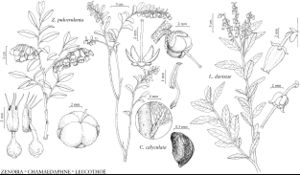Chamaedaphne
Methodus, 457. 1794, name conserved ,.
| Taxon | Illustrator ⠉ | |
|---|---|---|
 | Zenobia Zenobia pulverulenta Chamaedaphne Chamaedaphne calyculata | Yevonn Wilson-Ramsey Yevonn Wilson-Ramsey Barbara Alongi Barbara Alongi |
Shrubs. Stems erect, ascending or spreading; twigs hairy, lepidote. Leaves persistent; blade usually oblong to elliptic, rarely obovate, coriaceous, margins entire or denticulate-crenulate, plane, abaxial surface glabrous, silvery, stramineous or brownish lepidote-scaled (splitting in age); venation reticulodromous. Inflorescences terminal, (leafy) racemes, (flowers secund), 8–20-flowered, (from buds produced in previous season). Flowers: sepals 5, distinct, ovate to broadly triangular; petals 5, connate ca. 3/4 their lengths, white, corolla cylindric to urceolate-cylindric, slightly narrowed at throat, lobes much shorter than tube, (glabrous); stamens 10, included; filaments ± straight, flattened, subulate, abruptly narrowed at base, papillate, glabrous, without spurs; anther with 2 awns (awns erect, tubular, as long as body), dehiscent by terminal or subterminal pore; pistil 5-carpellate; ovary 5-locular; (style enlarged just distal to ovary); stigma slightly expanded, truncate. Fruits capsular, depressed-globose, dry-dehiscent, (with unthickened sutures). Seeds 35–50, wedge-shaped, flattened, (without wings); testa reticulate, (cells isodiametric). x = 11.
Distribution
North America, Eurasia
Discussion
Cassandra D. Don
Species 1: North America, Eurasia.
Chamaedaphne has been included in other genera of subfamily Vaccinioideae (Andromeda, Lyonia) and more recently has been placed in tribe Gaultherieae (K. A. Kron et al. 2002). Its leaf anatomy differs from that of other genera in having venation transitional between pleuroplastic and basiplastic types, denser venation, and thin vein endings (K. Lems 1964).
Species 1
Selected References
None.
Lower Taxa
"/4" is not declared as a valid unit of measurement for this property.